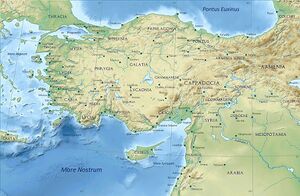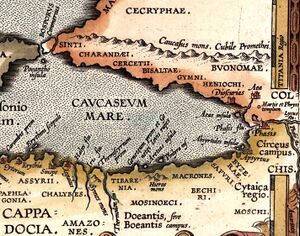Macrones
| Author:Laxman Burdak, IFS (R) |


Macrones were an ancient Colchian tribe in the east of Pontus, about the Moschici Mountains (modern Yalnizçam Dağlari, Turkey). The name is allegedly derived from the name of Kromni valley (Κορούμ, located 13 km north-east of Gümüşhane) by adding Kartvelian ma- prefix which denotes regional descendance.[1]
Variants
- Macrones (Pliny.vi.4)
- Georgian: მაკრონები)
- Ancient Greek: Μάκρωνες, Makrōnes
Jat Gotras Namesake
History
The Macrones are first mentioned by Herodotus (c. 450 BC), who relates that they, along with Moschi, Tibareni, Mossynoeci, and Marres, formed the nineteenth satrapy within the Achaemenid Persian Empire and fought under Xerxes I. There are many other subsequent references to them in the Classical accounts.
Xenophon (430-355 BC) places them east of Trapezus (modern Trabzon, Turkey). They are described as a powerful and wild people wearing garments made of hair, and as using in war wooden helmets, small shields of wicker-work, and short lances with long points.[2] Strabo (xii.3.18) remarks, in passing, that the people formerly called Macrones bore in his day the name of Sanni, a claim supported also by Stephanus of Byzantium, though Pliny speaks of the Sanni and Macrones as two distinct peoples.
By the 6th century they were known as the Tzanni (Ancient Greek: Τζάννοι). According to Procopius, the Byzantine emperor Justinian I subdued them in the 520s and converted them to Christianity.[3] They participated in the Lazic War fighting under the Byzantine command.
The Macrones are identified by modern scholars as one of the proto-Georgian tribes[4] whose presence in Northeastern Anatolia might have preceded the Hittite period, and who survived the demise of Urartu.[5] They are frequently regarded as the possible ancestors of the Mingrelians and Laz people (cf. margal, a Mingrelian self-designation).[6]
The Macrones lived along the border with the Machelonoi, another "Sannic" tribe evidently closely related to the Macrones.[7]
Mention by Pliny
Pliny[8] mentions.... We find here the nations of the Genetæ7 the Chalybes8, the town of Cotyorum9, the nations of the Tibareni and the Mossyni, who make marks upon their bodies,10 the people called Macrocephali11, the town of Cerasus12, the port of Chordule, the nations called the Bechires13 and the Buzeri, the river Melas14, the people called the Macrones, and Sidene with its river Sidenus15, by which the town of Polemonium16 is washed, at a distance from Amisus of one hundred and twenty miles.
7 Strabo speaks of a promontory called Genetes; and Stephanus Byzantinus mentions a river and port of the same name.
8 Strabo places the Chaldei, who, he says, were originally called Chalybes, in that part of the country which lies above Pharnacia (the modern Kerasunt).
9 Or Cotyora. According to Xenophon, this was a colony of Sinope, which furnished supplies for the Ten Thousand in their retreat. The place was on a bay called after the town. Hamilton, in his Researches, &c., Vol. i., is of opinion that Cotyorum may have stood on the site of Ordou, where some remains of an ancient port, cut out of the solid rock, are still visible. He remarks, however, that some writers suppose that Cotvora was the modern bay of Pershembah, which is more sheltered than Ordou. Cotyora was the place of embarkation of the Ten Thousand.
10 Similar to what we call tatooing. Parisot suggests that these people may have been the ancestors of the Mongol tribes who still dwell in tents similar to those mentioned by Mela as used by the Mossyni.
11 Or the "long-headed people."
12 Its site is not improbably that of the modern Kheresoun, on the coast of Asia Minor, and west of Trebizond. Lucullus is said to have brought thence the first cherry-trees planted in Europe.
13 It has been remarked, that Pliny's enumeration of names often rather confuses than helps, and that it is difficult to say where he intends to place the Bechires. We may perhaps infer from Mela that they were west of Trapezus and east of the Thermodon.
14 Now the Kara Su, or Black River, still retaining its ancient appellation. It rises in Cappadocia, in the chain of Mount Argæus.
15 Still called by the same name, according to Parisot, though sometimes it is called the river of Vatisa. More recent authorities, however, call it Poleman Chai.
16 On the coast of Pontus, built by king Polémon, perhaps the Second.
Mention by Pliny
Pliny[9] mentions.... Beyond these8 (Paryadres) are the deserts of Colchios, on the side of which that looks towards the Ceraunian Mountains dwell the Armenochalybes9; and there is the country of the Moschi, extending to the river Iberus, which flows into the Cyrus; below them are the Sacassani, and after them the Macrones, upon the river Absarus.
8 To the west.
9 "The Armenian workers in iron," or "Chalybes of Armenia." See p. 9.
References
- ↑ Kavtaradze, Giorgi Leon (2002). "An Attempt To Interpret Some Anatolian And Caucasian Ethnonyms Of The Classical Sources". Sprache und Kultur. Staatliche Ilia Tschawtschawadse Universität Tbilisi für Sprache und Kultur. Institut zur Erforschung des westlichen Denkens. 3: 68–83.
- ↑ Herodotus ii. 104, vii. 78; Xenophon Anabasis iv. 8. § 3, v. 5. § 18, vii. 8. § 25; comp. Hecataeus Fragm. 191; Scylax, p. 33; Dionysius Periegetes 766; Apollonius of Rhodes ii. 22; Pliny the Elder (1st century AD) vi. 4; Josephus c. Apion. i. § 22, who asserts that they observed the custom of circumcision).
- ↑ Procopius Bell. Pers. i. 15, Bell. Goth. iv. 2, de Aed. iii. 6.
- ↑ Suny, Ronald Grigor (1994), The Making of the Georgian Nation: 2nd edition, p. 8. Indiana University Press, ISBN 0-253-20915-3
- ↑ Bryer, A. & Winfield, D. (1985). The Byzantine Monuments and Topography of the Pontos, p. 300. DOS 20 (Washington, DC), I. Cited in: Kavtaradze (2002), pp. 63-83.
- ↑ Kavtaradze, Giorgi Leon (2002). "An Attempt To Interpret Some Anatolian And Caucasian Ethnonyms Of The Classical Sources". Sprache und Kultur. Staatliche Ilia Tschawtschawadse Universität Tbilisi für Sprache und Kultur. Institut zur Erforschung des westlichen Denkens. 3: 68–83.
- ↑ Edwards, Robert W. (1988), "The Vale of Kola: A Final Preliminary Report on the Marchlands of Northeast Turkey", p. 130. Dumbarton Oaks Papers, Vol. 42.
- ↑ Natural History by Pliny Book VI/Chapter 4
- ↑ Natural History by Pliny Book VI/Chapter 11
Back to Jat Places

